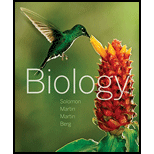
Biology (MindTap Course List)
11th Edition
ISBN: 9781337392938
Author: Eldra Solomon, Charles Martin, Diana W. Martin, Linda R. Berg
Publisher: Cengage Learning
expand_more
expand_more
format_list_bulleted
Concept explainers
Question
Chapter 21, Problem 5TYU
Summary Introduction
Concept introduction: Molecular systematics helps the biologist to interpret the fossil record to assume the evolutionary history of animals. The scanty availability of fossils is always an obstacle for the biologist to detect the rate of divergence, age, and the number of branches of the animal groups.
Expert Solution & Answer
Want to see the full answer?
Check out a sample textbook solution
Students have asked these similar questions
Describe a method to document the diffusion path and gradient of Sonic Hedgehog through the chicken embryo. If modifying the protein, what is one thing you have to consider in regards to maintaining the protein’s function?
The following table is from Kumar et. al. Highly Selective Dopamine D3 Receptor (DR) Antagonists and Partial Agonists Based on Eticlopride and the D3R Crystal Structure: New Leads for Opioid Dependence Treatment. J. Med Chem 2016.
The following figure is from Caterina et al. The capsaicin receptor: a heat activated ion channel in the
pain pathway. Nature, 1997. Black boxes indicate capsaicin, white circles indicate resinferatoxin.
You are a chef in a fancy new science-themed restaurant. You have a recipe that calls for 1 teaspoon of resinferatoxin, but you feel uncomfortable serving foods with "toxins" in them. How much capsaicin could you substitute instead?
Chapter 21 Solutions
Biology (MindTap Course List)
Ch. 21.1 - Describe the conditions that scientists think...Ch. 21.1 - Compare the prebiotic soup hypothesis with the...Ch. 21.1 - Prob. 1CCh. 21.1 - How does the ironsulfur world hypothesis differ...Ch. 21.2 - Outline the major steps hypothesized to have...Ch. 21.2 - Explain how the evolution of photosynthetic...Ch. 21.2 - Prob. 5LOCh. 21.2 - Prob. 1CCh. 21.2 - Prob. 2CCh. 21.2 - VISUALIZE Draw a simple sketch illustrating the...
Ch. 21.3 - Briefly describe the distinguishing organisms and...Ch. 21.3 - What is the correct order of appearance in the...Ch. 21.3 - Prob. 2CCh. 21.3 - What is the correct order of appearance in the...Ch. 21 - Energy, the absence of molecular oxygen, chemical...Ch. 21 - Prob. 2TYUCh. 21 - Prob. 3TYUCh. 21 - According to the hypothesis of serial...Ch. 21 - Prob. 5TYUCh. 21 - Prob. 6TYUCh. 21 - Prob. 7TYUCh. 21 - The time of greatest evolutionary diversification...Ch. 21 - Prob. 9TYUCh. 21 - The Age of Reptiles corresponds to the (a)...Ch. 21 - Evidence exists that a catastrophic collision...Ch. 21 - Flowering plants and mammals diversified and...Ch. 21 - Prob. 13TYUCh. 21 - EVOLUTION LINK If you were studying how...Ch. 21 - EVOLUTION LINK If living cells were produced in a...Ch. 21 - EVOLUTION LINK Why did the evolution of...Ch. 21 - INTERPRET DATA Evidence for the oldest...
Knowledge Booster
Learn more about
Need a deep-dive on the concept behind this application? Look no further. Learn more about this topic, biology and related others by exploring similar questions and additional content below.Similar questions
- What protein is necessary for packaging acetylcholine into synaptic vesicles?arrow_forward1. Match each vocabulary term to its best descriptor A. affinity B. efficacy C. inert D. mimic E. how drugs move through body F. how drugs bind Kd Bmax Agonist Antagonist Pharmacokinetics Pharmacodynamicsarrow_forward50 mg dose of a drug is given orally to a patient. The bioavailability of the drug is 0.2. What is the volume of distribution of the drug if the plasma concentration is 1 mg/L? Be sure to provide units.arrow_forward
- Determine Kd and Bmax from the following Scatchard plot. Make sure to include units.arrow_forwardChoose a catecholamine neurotransmitter and describe/draw the components of the synapse important for its signaling including synthesis, packaging into vesicles, receptors, transporters/degradative enzymes. Describe 2 drugs that can act on this system.arrow_forwardThe following figure is from Caterina et al. The capsaicin receptor: a heat activated ion channel in the pain pathway. Nature, 1997. Black boxes indicate capsaicin, white circles indicate resinferatoxin. a) Which has a higher potency? b) Which is has a higher efficacy? c) What is the approximate Kd of capsaicin in uM? (you can round to the nearest power of 10)arrow_forward
arrow_back_ios
SEE MORE QUESTIONS
arrow_forward_ios
Recommended textbooks for you
 Concepts of BiologyBiologyISBN:9781938168116Author:Samantha Fowler, Rebecca Roush, James WisePublisher:OpenStax College
Concepts of BiologyBiologyISBN:9781938168116Author:Samantha Fowler, Rebecca Roush, James WisePublisher:OpenStax College
 Biology: The Dynamic Science (MindTap Course List)BiologyISBN:9781305389892Author:Peter J. Russell, Paul E. Hertz, Beverly McMillanPublisher:Cengage Learning
Biology: The Dynamic Science (MindTap Course List)BiologyISBN:9781305389892Author:Peter J. Russell, Paul E. Hertz, Beverly McMillanPublisher:Cengage Learning Biology (MindTap Course List)BiologyISBN:9781337392938Author:Eldra Solomon, Charles Martin, Diana W. Martin, Linda R. BergPublisher:Cengage Learning
Biology (MindTap Course List)BiologyISBN:9781337392938Author:Eldra Solomon, Charles Martin, Diana W. Martin, Linda R. BergPublisher:Cengage Learning Biology Today and Tomorrow without Physiology (Mi...BiologyISBN:9781305117396Author:Cecie Starr, Christine Evers, Lisa StarrPublisher:Cengage Learning
Biology Today and Tomorrow without Physiology (Mi...BiologyISBN:9781305117396Author:Cecie Starr, Christine Evers, Lisa StarrPublisher:Cengage Learning

Concepts of Biology
Biology
ISBN:9781938168116
Author:Samantha Fowler, Rebecca Roush, James Wise
Publisher:OpenStax College


Biology: The Dynamic Science (MindTap Course List)
Biology
ISBN:9781305389892
Author:Peter J. Russell, Paul E. Hertz, Beverly McMillan
Publisher:Cengage Learning

Biology (MindTap Course List)
Biology
ISBN:9781337392938
Author:Eldra Solomon, Charles Martin, Diana W. Martin, Linda R. Berg
Publisher:Cengage Learning

Biology Today and Tomorrow without Physiology (Mi...
Biology
ISBN:9781305117396
Author:Cecie Starr, Christine Evers, Lisa Starr
Publisher:Cengage Learning

Endosymbiotic Theory; Author: Amoeba Sisters;https://www.youtube.com/watch?v=FGnS-Xk0ZqU;License: Standard Youtube License